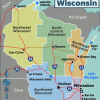Source: US News —
Over the next five years, look for several important trends accelerated by the COVID-19 pandemic to begin having lasting impacts on real estate and land use, many of which will impact the demand and supply in regional housing markets. Whether due to emerging technologies, changing demographics, the state of local job markets or the rise of remote work, the list of the hottest housing markets in 2027 may look a bit different from a similar list today.
Our data is sourced from several authoritative sources, including the U.S. News Housing Market Index, an interactive platform providing a data-driven overview of the housing market nationwide. See the U.S. News Housing Market Index.
2023 Will Bring Continued Uncertainty for the Housing Market
As we enter 2023, it’s reasonable to feel disoriented about the state of the economy and the housing market. Since we’re likely still in the remaining innings of a global pandemic of historic proportions, economists offering glimpses into the future seem to agree on only one thing: continuing uncertainty.
That’s mostly because when economists create their forecasting models, they’re relying on past performance – and the more data, the better. But what happens when the data becomes so skewed due to a “black swan” event such as a global pandemic that these forecasting models break down?
If you’re the Federal Reserve setting monetary policy, what happens is a lot of guesswork and regular updates to the paths of everything from GDP growth and inflation to setting interest rates and how much to support the banking and mortgage markets.
During past pandemics, there were rapid advances in public health, patient care, quality of housing and even art. Although cities decimated by past pandemics, including the 14th century’s Black Death, usually prospered in time, today the widespread availability of instant communications makes cities much less important to conduct day-to-day business for up to 45% of the country’s workforce. That will impact land use.
In addition, the pandemic break gave many Americans a glimpse of what life could be like without the stresses of juggling demanding careers and supporting families around lengthy commutes. Despite the enormous pain and suffering brought by COVID-19, historians may look back at this time as an important inflection point when much of the U.S. workforce insisted on keeping a substantial share of the work-life balance they enjoyed during the pandemic. That will also impact land use.
Mortgage Rate Forecast
Given the rapid rise in mortgage rates and the related decline in affordability during 2022, it stands to reason that home values would need to adjust accordingly. Since its last peak in June 2022, the national S&P CoreLogic Case Shiller Index fell by 3% through October, and median home prices are predicted to fall 5.3% in 2023 as long as mortgage rates remain relatively high.
This larger decline was due to homeowners facing a deepening recession as well as payments for many “option ARM” adjustable-rate mortgages resetting higher, forcing them to sell into a declining market, deed the home back to the lender or risk foreclosure proceedings. Fortunately, there are no signs of these types of national declines in home values for three reasons: low inventory, higher-quality mortgages with no option ARMs, and little chance of the same type of severe recession resulting from the financial crisis.
Still, while mortgage rates are falling now as inflation subsides, mortgage bond holders are well aware of several economic wildcards in the year ahead that could limit rates falling significantly due to the additional uncertainty. Whether it’s another potential surge of COVID-19 cases due to the low uptake of vaccine boosters, the extent to which China’s reopening will impact energy markets and inflation or the path and duration of the Russia-Ukraine war, mortgage investors may prefer to retain some extra wiggle room to compensate them for added risks.
While it’s quite possible for median home prices to fall another 5% in 2024 – or a total potential drop of about 10% from the end of 2022 – if mortgage rates decline faster than predicted, that could mean home prices remain mostly flat through the end of 2024. However, if real incomes rise faster than inflation, the combination of that extra purchasing power plus lower mortgage rates would boost affordability, home sales and prices.
If that happens from 2025 through 2027, look for home prices to start rising again by approximately 1% to 2% above the current inflation rate. But it will likely take some time to reach the home value heights of mid-2022.
Housing Market Has Yet to React to ‘Hollowing Out’ of Big Cities
Once the flexibility known as work from home was widely offered in early 2020, a large share of the American workforce was able to discover the advantages of avoiding a daily commute. As it turns out, many of them were not interested in returning to the pre-pandemic status quo.















